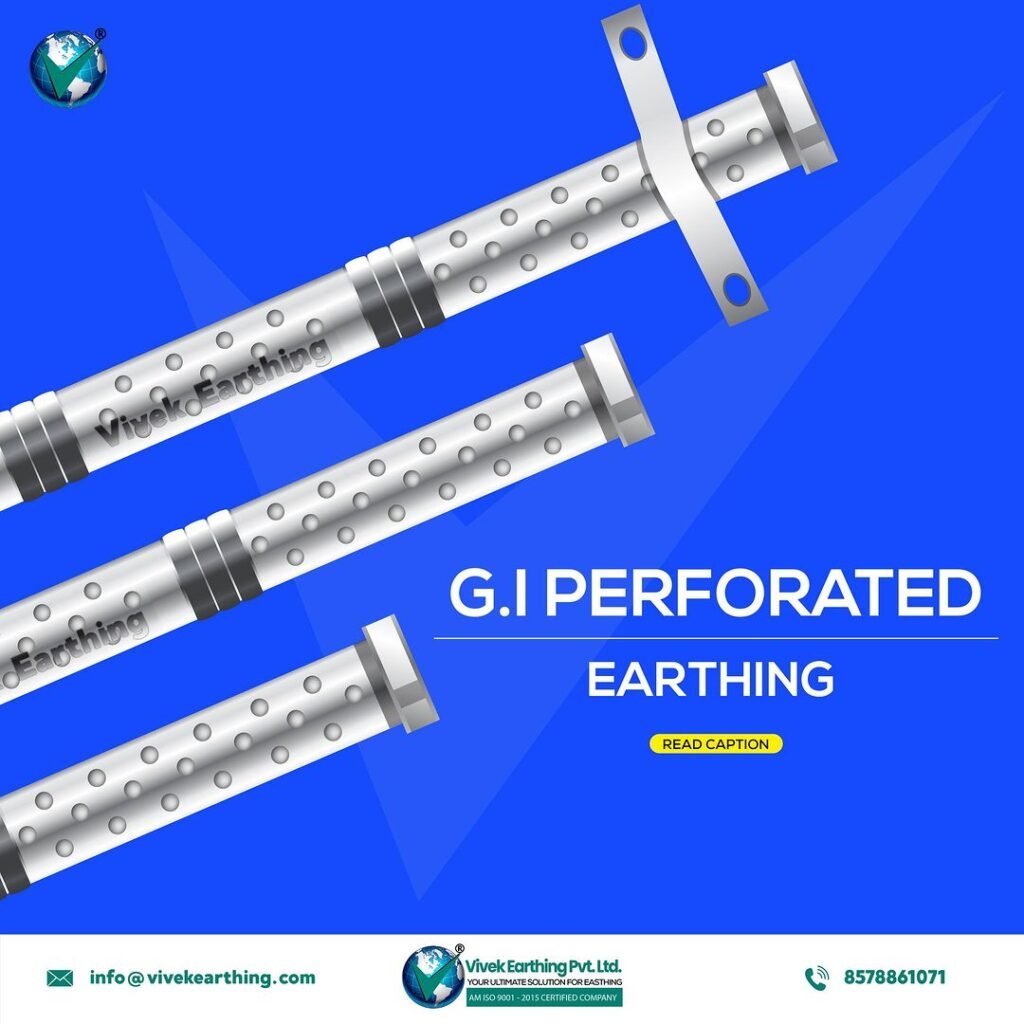Overview
G.I. Perforated Earthing Pipe is a crucial component in modern electrical earthing systems. Made from high-quality galvanized iron, these pipes ensure a safe and efficient path for fault currents to dissipate into the earth, thereby protecting electrical systems and structures from damage.

The Importance of Earthing in Electrical Systems
Earthing is essential for the safety of electrical systems. It prevents electric shock hazards by providing a path for fault currents to flow directly into the ground. This process is vital in both domestic and commercial settings to protect equipment and individuals.
Understanding the G.I. perforated Earthing Pipe
G.I. Perforated Earthing Pipe is designed for optimal conductivity and durability. The perforations along the pipe enhance its contact with the surrounding soil, improving the earthing system’s effectiveness. These pipes are often used in areas where soil resistivity is high, providing a reliable earthing solution.
Installation Process of G.I Perforated Earthing Pipe
Installing a G.I Perforated Earthing Pipe is a critical process that ensures the safety and efficiency of an electrical earthing system. Follow these key steps for an effective installation:
1. Site Selection:
Choose a location away from building foundations and water pipelines.
Ensure the site has consistent soil moisture for better conductivity.
2. Preparing the Earth Pit:
Dig a pit with dimensions suitable for the length and diameter of the pipe.
The standard depth should be around 3 meters, but this may vary based on soil conditions and pipe specifications.
3. Pipe Preparation:
Use a high-quality G.I Perforated Earthing Pipe, typically 40mm in diameter.
Ensure the pipe is perforated along its length for better soil contact.
4. Positioning the Pipe:
Place the pipe vertically in the pit, ensuring it reaches the desired depth.
The tapered end should be positioned downwards.
5. Enhancing Soil Conductivity:
Backfill the pit with layers of salt and charcoal or use conductive compounds to reduce soil resistivity.
This step is crucial for maintaining effective earthing, especially in dry or rocky soil conditions.
6. Securing the Connection:
Attach the earthing wire to the top terminal of the pipe using durable clamps.
Ensure a tight and corrosion-resistant connection for long-term reliability.
7. Final Checks and Covering:
Conduct a resistance test to ensure the installation meets safety standards.
Cover the pit, leaving access for periodic maintenance and watering if necessary.
8. Regular Maintenance:
Schedule periodic inspections to check for corrosion or damage.
Maintain soil moisture around the earthing pit, especially in dry seasons.
By following these steps, you can ensure that your G.I Perforated Earthing Pipe is installed correctly, providing a safe and effective grounding solution for your electrical systems.

Benefits of Using G.I Perforated Earthing Pipe
Using G.I. Perforated Earthing Pipe offers numerous benefits, such as enhanced safety, reduced soil resistivity, and increased lifespan of the earthing system. This section will explore these advantages in detail.
Maintenance and Longevity of G.I Perforated Earthing Pipes
Proper maintenance is key to ensuring the longevity of G.I. Perforated Earthing Pipes. Regular checks and appropriate upkeep can significantly extend the life of these earthing components.
Comparing G.I. Perforated Earthing Pipe with Other Earthing Methods
This section will compare G.I Perforated Earthing Pipe with other earthing methods, highlighting its unique features and why it is often the preferred choice for many applications.
Case Studies: Success Stories with G.I Perforated Earthing Pipe
Real-world examples and case studies will be presented to illustrate the effectiveness of G.I Perforated Earthing Pipe in various settings, from residential buildings to industrial complexes.
Conclusion
Vivek Earthing, G.I. Perforated Earthing Pipe stands out as a reliable, efficient, and safe solution for earthing requirements. Its unique properties and proven track record make it an ideal choice for a wide range of applications.
FAQs
1. What is a G.I Perforated Earthing Pipe?
Ans. G.I. Perforated Earthing Pipe is a galvanized iron pipe used in electrical earthing systems. It’s designed with perforations along its length to enhance contact with the soil, thereby improving the earthing system’s effectiveness.
2. How does G.I Perforated Earthing Pipe enhance electrical safety?
Ans. This type of earthing pipe provides a reliable path for fault currents to safely dissipate into the earth. This reduces the risk of electrical shocks, equipment damage, and fire hazards in electrical systems.
3. Where is G.I Perforated Earthing Pipe most commonly used?
Ans. It’s widely used in residential, commercial, and industrial settings, particularly where soil resistivity is high and a robust earthing system is required for safety and compliance with electrical standards.
4. What are the key benefits of using G.I Perforated Earthing Pipe?
Ans. Key benefits include improved electrical safety, enhanced system reliability, reduced soil resistivity, and increased durability of the earthing system. It’s also easy to install and requires minimal maintenance.
5. How do I maintain a G.I Perforated Earthing Pipe system?
Ans. Regular maintenance involves inspecting for corrosion, ensuring connections are tight and secure, and checking the soil moisture levels around the pipe. Periodic resistance testing is also recommended to ensure optimal performance.



One Response